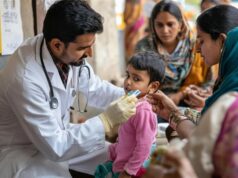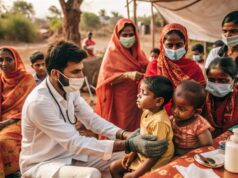Universal Health Coverage (UHC) is one of India’s most ambitious national goals. To achieve it, the government created sweeping policies and programmes. However, their implementation in rural areas continues to be marred by policy-based challenges in terms of accessibility, availability, and affordability, particularly in the management of non-communicable diseases (NCDs).
NCDs, including diabetes, obesity, and heart disease, are no longer an urban phenomenon and have become more widespread in rural India. However, healthcare systems present in these parts are not adequately equipped to handle the strain. This results in preventable deaths and severe financial distress for families. In 2016, of the 15.6 million deaths in low and middle-income countries due to 61 conditions outlined in the Sustainable Development Goals, 8.6 million were linked to healthcare, of which five million were due to poor quality of healthcare and 3.6 million due to non-utilisation of healthcare1. It is necessary to recognise the loopholes in policies and formulate targeted solutions to address this growing issue.
Policy gaps and their consequences
In India, almost 65% of the population resides in rural areas2. Despite policies to provide comprehensive care, significant gaps persist in the healthcare delivery system, impacting a significant part of the population. These gaps, which imperil the effective management of NCDs, are:
- Inadequate infrastructure: Many primary health centres (PHCs) lack basic diagnostic equipment and resources, making it difficult to provide even basic healthcare services to the population. Furthermore, an inadequate number of healthcare facilities, poorly maintained facilities, and disproportionate access to advanced healthcare services worsen existing challenges3. Many patients are forced to travel hundreds of kilometres for even screening. This results in a time lost between screening and diagnosis, which is detrimental to managing NCDs.
- Medication availability challenges: Health schemes often comprise subsidised or free medication for NCDs, but the supply chains in public healthcare facilities in rural areas are often unreliable. This forces patients to procure medicines from private pharmacies at market rates, placing a heavy financial burden on them. Furthermore, these pharmacies may not have an adequate supply of relatively inexpensive branded or generic alternatives4. This results in poor adherence and outcomes among patients.
- Inconsistent care continuum: Patients with NCDs require continuous, long-term care accompanied by follow-ups. However, in many cases, the rural healthcare system is poorly equipped for this. Patient records are fragmented and often poorly maintained, resulting in a loss of medical history. There is no watertight system that tracks patients and reminds them about follow-up appointments5. Moreover, high turnover rates of medical staff in rural areas disrupt patient-provider relationships6. These challenges hinder consistent and personalised care.
Targeted solutions
The country’s commitment to UHC is evident through initiatives such as Ayushman Bharat. However, the policy framework must be reformed for this promise to translate into tangible health benefits for rural populations, particularly in the face of a rising NCD burden. Some of the solutions are:
- Establishing decentralised diagnostic hubs: The solution to the lack of adequate diagnostic infrastructure at the village and sub-centre level is to move away from a centralised model wherein patients must travel long distances to district hospitals for basic tests. A “hub-and-spoke” model can be implemented. A primary diagnostic hub equipped with essential equipment can be established at the block level. These hubs will act as a central point connected to clinics in surrounding villages.
- Improving medication supply chains: To address the erratic supply of medication at local clinics, a more resilient and technology-driven supply chain is needed. For this, a digital inventory management system can be deployed at every level of the healthcare chain, from state warehouses to local PHCs. This system can keep track of stock in real-time, facilitating accurate demand forecasting and automated reordering, thus preventing shortages. Furthermore, a last-mile delivery system can be created by leveraging existing community networks.
- Digitalise health data: To reduce the fragmentation of patient information across different health facilities, a unified digital health ecosystem is the only sustainable solution. As part of the Ayushman Bharat Digital Mission (ABDM), every citizen must receive an Ayushman Bharat Health Account (ABHA), a unique health ID that links all their health records. An interoperable electronic health record (EHR) system must be set up to allow this data to be shared securely between a sub-centre, a PHC, and a district hospital. It should be accessible through online and offline modes, especially in areas with poor internet connectivity. Moreover, patient privacy and security must be given equal priority in such systems.
- Expanding the role of ASHA workers: The role of ASHA workers can be expanded to include NCD prevention and management. They can act as a bridge between the formal health system and the community. For that, they must undergo training on using screening devices such as digital blood pressure monitors or glucose monitors, providing basic advice on diet, exercise, and tobacco cessation, reminding patients about their medication, and using digital tools (e.g., tablets or smartphones) to record patient data and schedule follow-ups.
The success of UHC in India will not be measured by the number of policies, but by its ability to save lives. The current policy loopholes in medication supply, diagnostic infrastructure, and continuity of care are critical barriers to effective NCD management in rural areas. These barriers turn chronic diseases into catastrophic health events that increase mortality and impoverish families. By implementing targeted reforms that focus on decentralised resources, digital integration, and community empowerment, the country can bridge these gaps and ensure health becomes a fundamental right for all.
[1]https://pmc.ncbi.nlm.nih.gov/articles/PMC6238021/
[2] https://www.pib.gov.in/pressreleasepage.aspx?prid=1894901
[3] https://pmc.ncbi.nlm.nih.gov/articles/PMC10292032/
[4] https://pmc.ncbi.nlm.nih.gov/articles/PMC4994301/
[5]https://publichealthreviews.biomedcentral.com/articles/10.1186/s40985-020-00128-3







